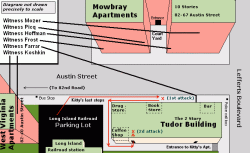Back
Home
Email Me
About Me
Read Guestbook
Guestbook Archives
Sign Guestbook
Where Are They?
What's New
Find It
Need It
Links
Books
Your Old Photos
1920's Map
Current Map

Back | Cont'd

The Kitty Genovese Murder Scene.
Click to enlarge.
Read the Trial Testimony
HTML PDF Robert Mozer
HTML PDF Andree Picq
HTML PDF Irene Frost
HTML PDF Samuel Koshkin
HTML PDF Sophie Farrar
HTML PDF Moseley's Direct
HTML PDF Moseley's Cross
HTML PDF Moseley's Confession
Read excerpts from the District Attorney's briefs
HTML PDF D.A.'s Brief [1]
HTML PDF D.A.'s Brief [2]
Read the affidavit of surviving witness, Michael Hoffman
HTML PDF Michael Hoffman
Additional source
Seedman & Hellman, Chief!, pp. 106, 112 - 142 (Arthur Fields Books, N.Y. 1974)
(Albert A. Seedman was the deputy police inspector who interrogated Moseley. Seedman went on to become Chief of Detectives and later included a chapter on the case in this memoir. N.B., Seedman and Hellman used fictitious names for the witnesses.)
Disclaimer
Throughout this page, I will cite to various media accounts of the case. I do so only for the factual statements they contain and not because the authors of those accounts agree with the opinions I express here.
In the Public Domain
My thoughts, comments and opinions about this case along with all images created by or for me are dedicated to the public domain. They may be copied and used without credit or compensation to me. I claim no rights in the trial transcript and briefs included here.
This page was created on January 14 2004 and revised on September 7, 2004 to include a reference to the night elevator operator.
The Murder of Kitty Genovese:
This Much is Certain
At 3:20 AM on March 13, 1964, Winston Moseley attacked Catherine (Kitty) Genovese in front of a 2 story Tudor building on Austin Street in Kew Gardens, NY about 50 ft. from a bar known to generate loud, late night rowdiness. He stabbed her twice in the back. Her screams awakened some residents of the Mowbray Apartment House across the street, several of whom went to their windows.
View present day photographs of the crime
scene. [1] [2] [3]
One witness, the building's night elevator operator, saw the stabbings and understood what was happening. Another thought she saw Moseley beating Kitty. Two others just saw Moseley standing or kneeling over her. One of these witnesses called out to Moseley to leave the girl alone.
As other residents began to awaken and come to their windows, Moseley ran to his car which was parked about 100 paces away. He put it in reverse and quickly backed it west on Austin Street - disappearing around the corner at 82nd Road, a block away.
View map
As he was doing this, Kitty got up and slowly made her way around to the rear of the 2 story Tudor building where none of the witnesses from the Mowbray Apartments could see her. She collapsed in a small hallway just inside one of the back entrances.
View more present day photographs of the
crime scene. [4] [5] [6]
View diagram
We know of 5 witnesses who were still at their windows when Moseley returned on foot about 10 minutes later. They watched from their apartment windows for about 2 minutes as Moseley appeared to search the area around a parking lot adjacent to the 2 story Tudor building.
View another present day photograph of the
crime scene. [7]
Moseley then went around to the back of the Tudor building where the witnesses could not see him, either. There he found Kitty laying in the hallway, and attacked again. Only one witness saw that second attack and he delayed calling the police because he was intoxicated. Kitty later died of her wounds in an ambulance.
Residents later said that some people called the police right after the first attack. At the time, the police said that only one person called and he had waited until after the second attack to do so.
Click here to read a detailed analysis of the March 27, 1964 New York Times article that broke the story.